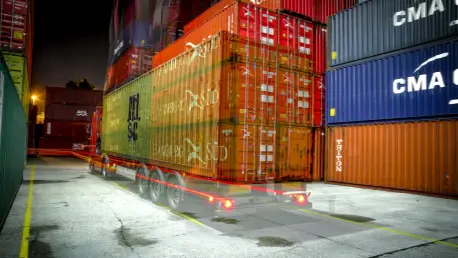The logistics landscape in the Philippines is at a pivotal juncture, where traditional challenges meet modern solutions. The industry has long served as a critical component of the nation’s economy, ensuring the seamless flow of goods and services. However, the sector has grappled with unique difficulties, including a fragmented operational structure, traffic congestion, limited infrastructure, and manual processes. These obstacles not only hinder efficiency but also elevate costs and diminish service quality. In an increasingly globalized world where speed, transparency, and reliability are paramount, the call for digital transformation in Philippine logistics grows more urgent.
Digital readiness represents a proactive approach to these challenges by integrating technology into logistics processes. This transformation includes moving from paper-based systems to comprehensive, data-centric platforms that offer real-time decision-making capabilities. Crucially, this change is not just about adopting new technologies; it involves instilling a new mindset that embraces innovation to enhance customer satisfaction, operational agility, and cost-effectiveness. By doing so, logistics companies in the Philippines can better navigate their complex geography, meet mounting e-commerce demands, and maintain competitiveness in the global supply chain.
1. Initiate Small, Think Smart
The first step toward digital transformation in logistics should involve initiating small but impactful changes. Digitizing a single process, such as shipment tracking or billing, can serve as a critical starting point. This approach allows logistics companies to assess the benefits of digital processes on a manageable scale before committing to larger changes. Gradual adoption not only mitigates risk but also engenders confidence among stakeholders, facilitating broader digital integration over time.
This incremental approach enables businesses to measure the effectiveness of new technologies in real-world scenarios, thereby refining strategies based on tangible outcomes. By starting with specific processes, companies can focus resources efficiently, ensuring that each digital tool implemented is fit for purpose and adds real value. Moreover, these initial steps can serve as a learning experience, helping organizations identify potential challenges and solutions for future initiatives. This measured strategy lays the foundation for a scalable digital transformation, reducing the likelihood of missteps and creating a culture of innovation.
2. Opt for Expandable Solutions
Implementing digital transformation requires an investment in platforms that are not only effective now but are also expandable for future growth. Opting for cloud-based solutions can offer Philippine logistics companies the flexibility and scalability required to adapt to evolving market demands. These platforms allow seamless integration with existing systems, ensuring that operations can expand without encountering significant disruptions or compatibility issues. The use of cloud technology offers the advantage of enhanced storage capacity, improved collaborative features, and accessibility from any location, thus supporting both local and regional logistics endeavors.
Selecting scalable platforms ensures that businesses remain agile, capable of accommodating business growth, and able to respond effectively to changing industry conditions. Integration capabilities are critical; they allow logistics firms to harmonize new technologies with their existing framework, reducing resistance to change and optimizing current workflows. As a result, companies are not only equipped to address present challenges but are also positioned to capitalize on new opportunities as technology continues to evolve. This readiness protects the longevity and competitiveness of the logistics sector, laying the groundwork for sustainable development.
3. Invest in Workforce
The success of a digital transformation largely hinges on the workforce that operates within this new paradigm. Educating teams and providing them with necessary digital skills is crucial. Employees are the backbone of any organization, and their involvement in the transformation process can significantly alter its outcome. By equipping them with the proper skills, logistics companies can ensure that their workforce is adept at handling new technologies and systems. Training programs should be comprehensive, addressing various aspects of digital tools and the strategic uses of these technologies to improve business outcomes.
Investing in the workforce also means fostering a culture of continuous improvement and learning. Employees should be encouraged to provide feedback on new systems, fostering an environment where innovation and adaptation are valued. By involving the workforce in the transformation process, companies not only enhance skill levels but also build trust and buy-in for digital initiatives. Ultimately, a well-trained and informed workforce is instrumental in pushing the boundaries of what is possible, facilitating the seamless integration of new technologies, and maximizing their impact.
4. Partner Across the Network
Collaboration is vital in driving forward digital transformation in logistics. Forming partnerships with technology providers, government agencies, and industry peers can facilitate a more coordinated approach to digital readiness. Such collaborations encourage the exchange of expertise and resources, helping logistics companies to overcome technological and infrastructural limitations, particularly in complex market environments like the Philippines. By pooling knowledge and capabilities, these partnerships can lead to the development of robust solutions tailored to specific challenges faced by the industry.
Partnerships also provide access to a wider network of support, offering logistical firms the opportunity to benefit from shared experiences and innovative practices. This network can serve as a platform for collectively addressing challenges such as regulatory hurdles, cost constraints, and technological implementation. Moreover, stakeholder collaboration fosters a sense of shared purpose and vision within the industry, driving progress through collective effort. These partnerships not only support immediate transformation goals but also inspire a culture of innovation that perpetuates long-term growth and sustainability.
The Path Forward
The logistics industry in the Philippines is at a crucial turning point, where enduring challenges intersect with modern solutions. As a vital part of the country’s economy, logistics is responsible for the efficient movement of goods and services. Nevertheless, the sector faces distinct hurdles, such as a fragmented operational framework, severe traffic congestion, inadequate infrastructure, and reliance on manual processes. These factors decrease efficiency, drive up costs, and lower service quality. In today’s globalized environment, where speed, transparency, and reliability are essential, the push for digital transformation in Philippine logistics becomes increasingly urgent.
Digital preparedness addresses these issues by integrating technology into logistics operations. This shift entails transitioning from paper-based systems to advanced, data-oriented platforms that allow for real-time decision-making. Importantly, this transformation isn’t just about technology adoption; it’s about fostering a culture of innovation to boost customer satisfaction, agility, and cost-effectiveness. This strategy enables Philippine logistics companies to better navigate a challenging geography, meet growing e-commerce demands, and remain competitive in the global supply chain.









